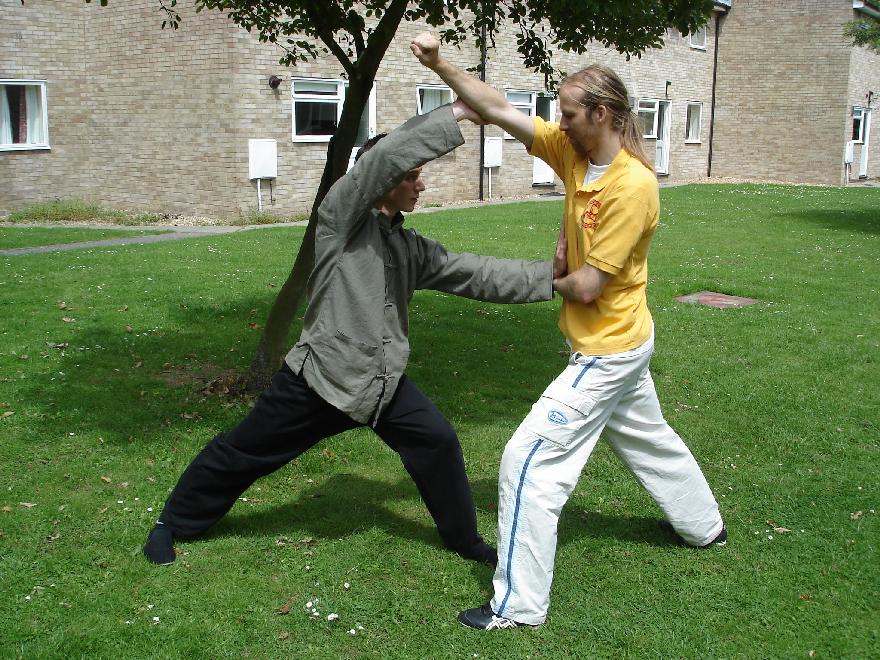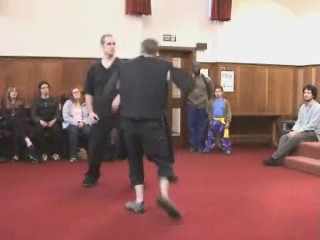IS KAITAN'S TAIJIQUAN OR WAHNAM TAIJIQUAN GENUINE, TRADITIONAL TAIJIQUAN?
 This is how Wahnam Taijiquan is used in combat
This is how Wahnam Taijiquan is used in combat
The following discussion is reproduced from the thread What is Genuine, Traditional Taijiquan? started in the Shaolin Wahnam Discussion Forum on 5th June 2006.
"Practicing genuine, traditional Taijiquan gives benefits like combat efficiency, good health, mental clarity and spiritual development."
-- Sifu Robin Gamble
![]() Sifu Robin Gamble
Sifu Robin Gamble
Instructor, Shaolin Wahnam England
22nd June 2006
I would like to conclude my series of posts with a summary of what has been discussed.
These posts are a response to Kaitain's insinuation that Wahnam Taijiquan is not Taijiquan.
To decide whether Kaitain's Taijiquan or Wahnam Taijiquan is genuine, traditional Taijiquan, I proposed to list the features of genuine, traditional Taijiquan, and to compare Kaitain's Taijiquan and Wahnam Taijiquan against these features.
To avoid going out of topic, we discussed the features under the following aspects:
- Principles.
- Form.
- Force.
- Application.
- Benefits.
A fundamental principle of genuine, traditional Taijiquan is to turn the opponent's momentum back to himself. This is accomplished by appropriate shen-fa, or body-movement.
Kaitain justifies his practice as Taijiquan although he admits that his forms are not Taijiquan forms, because he says he uses Taijiquan principles, and he mentions shen-fa, or body-movement, as an example. But the fact is that Kaitain does not use the body-movement of genuine, traditional Taijiquan; he uses the body-movement of Boxing.
Kaitain does not use body-movement to turn an opponent's momentum against himself. Instead, Kaitain uses force against force head-on. This is contrary to the principles of genuine, traditional Taijiquan.
In contrast, Wahnam Taijiquan pays much attention to utilizing body-movement to turn an opponent's momentum against himself. When an opponent attacks, a Wahnam Taijiquan exponent first yields to his momentum, next deflects the momentum, and then redirect the momentum back to the opponent, all in one smooth movement. This is following the principles of genuine, traditional Taijiquan.
Kaitian uses Boxing and Wrestling forms in his version of Taijiquan. His justification that form is unimportant is basically flawed. While form is not everything in genuine, traditional Taijiquan, it is still important, and often it is by its outward form that an art, rightly or wrongly, is identified.
Practicing Boxing or Wrestling forms but calling them Taijiquan is ridiculous. This is exactly what Kaitian does.
 This is how Kaitan's Taijiquan is used in combat
This is how Kaitan's Taijiquan is used in combat
On the other hand, the forms practiced in Wahnam Taijiquan are unmistakably Taijiquan forms. Hence, regarding form, Wahnam Taijiquan is certainly closer to genuine, traditional Taijiquan than Kaitain's Taijiquan.
Taijiquan is an internal art. Its force, therefore, is internal force, and not muscular strength. The onus of internal force training is chi.
Kaitain is ignorant of chi and internal force, as is evident in his many statements. He uses muscular strength, and his force training involves punching sandbags. On the other hand, Wahnam Taijiquan pays much attention to internal force. Our force training involves chi.
Kaitian does not believe that Taijiquan techniques are combat effective.
Therefore he uses Boxing and Wrestling techniques in combat although he calls his art Taijiquan. In contrast, in Wahnam Taijiquan the techniques we use in combat are typically Taijiquan techniques, the same as those used by Taijiquan masters in the past. Hence, regarding combat application Wahnam Taijquan is closer to genuine, traditional Taijiquan than Kaitain's Taijiquan.
Practicing genuine, traditional Taijiquan gives benefits like combat efficiency, good health, mental clarity and spiritual development.
Kaitain uses Boxing and Wrestling techniques, instead of Taijiquan techniques, for combat. Hence Kaitain's Taijiquan is not combat effective. Kaitian emphasizes on muscular power in his training, which results in much blockage. Hence, Kaitain's Taijiquan does not contribute to good health. Kaitain openly invites challenges, which does not speak well of mental clarity. Kaitain seems to be very proud to have injure his students in demonstration, which does not speak well of spiritual development. In short, Kaitain's version of Taijiquan does not give the kind of benefits that genuine, traditional Taijiquan will give.
In contrast, Wahnam Taijiquan uses typical Taijiquan techniques for combat. Hence, Wahnam Taijiquan is combat effective. Wahnam Taijiquan emphasizes on chi flow and internal force, which contribute to good health. Wahnam Taijiquan practitioners assess Kaitain's accusations calmly and respond after careful consideration, indicating mental clarity. Despite Kaitain's rudeness and arrogance, Wahnam Taijiquan practitioners respond with patience and respect, indicating spiritual development.
Considering all these, is Kaitain Taijiquan or Wahnam Taijiquan genuine, traditional Taijiquan? I shall leave forum members to make their own verdict.
-
1: Friendly Sparring?
-
2: And Now You Back Down
-
3: Shen-Fa or Body-Movement and Other Principles of Genuine, Traditional Taijiquan
-
4: Calling a Cow a Horse
-
5: The Reality of Chi and Internal Force
-
6: Could Yang Lu Chan Defeat Modern Ultimate Fighting Arts Fighters
-
7: Chi and Internal Force in Genuine, Traditional Taijiquan
-
8: It is Amazing some Instructors would Miss an Opportunity than Learn from another Master
-
9: On Principles, Stances, Force and Age in Taijiquan
-
10: In Genuine Kungfu, Size, Weight, Age and Sex are Not Decisive Factors in Combat
-
11: How to Improve your Mental Clarity
-
12: Boxing is Boxing, Taijiquan is Taijiquan
-
13: The Benefits Students Get from Kaitan's Taijiquan and from Wahnam Taijiquan
-
14: Harmonious Chi has a place Everywhere, and Internal Force is Real
-
15: Some Interesting Questions on Internal Force
-
16: Internal Force is an Essential Part of Genuine, Traditional Taijiquan
-
17: Is Kaitain's Taijiquan or Wahnam Taijiquan genuine, traditional Taijiquan
-
18: Cloud Hands, Silk Reeling and Grasping Sparrow's Tail
